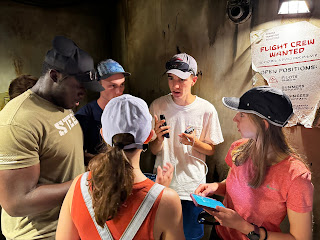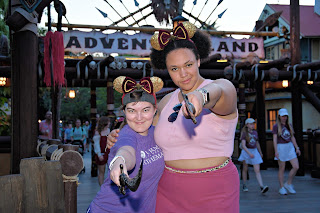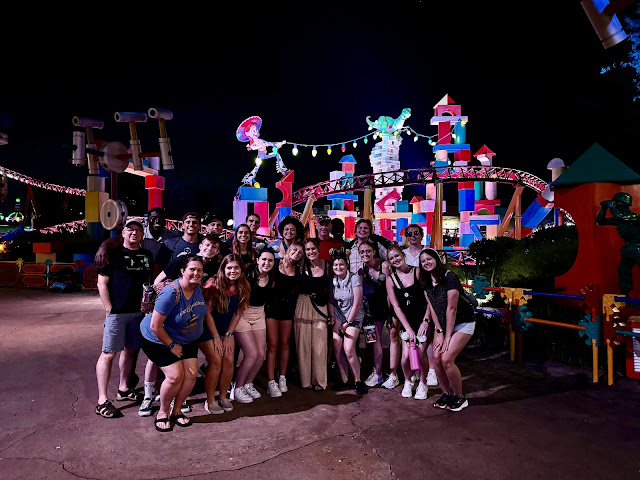To finish the blog for this Math and the Mouse course, we asked the students to reflect on their experiences by submitting phrases that they thought exemplified the trip. We’ve compiled these into a Top Ten List.
10. The Food
We had three big meals at the Disney restaurants Roundup Rodeo, Biergarten, and Boma. These meals introduced the group to many delicious treats, but also had some unexpected delights. Roundup Rodeo had the surprise of students eating whole rib bones and the transformation of one table into the League of Southern Women. Biergarten tested the limits of our stomachs, but several students visited the most puke-inducing ride in Epcot, Mission Space, afterwards without incident. Finally, Boma offered us delicious American-style West African food, POG juice, and the most flavorful strawberries some of us had ever eaten. The breakfast tacos, Mickey waffles, frequent meals from Firehouse Subs and Pita, $4 baguettes in France, Mickey Bars, the Clearly Furman and Splitsville spreads, and Twistee Treats balanced out the peanut butter and banana sandwiches that students made for lunch. We had a tasty time!
9. Speedwalking and Exhaustion
8. The Van Rides
Van rides were an opportunity to explore new music, such as Bouncing Balls by The Wiggles and Numbers (I Can Only Count to Four) by Psychostick. It also supplied ample opportunity to play (and sing-along with) Disney favorites. In fact, Dr. Hutson visited the Frozen Family Sing Along without actually stepping into the actual attraction thanks to the voices of our students.
7. The Hotel Lobby
The hotel lobby/breakfast area served as the location for the professors’ office hours. All of the groups would work there to have easy access to the professors. It became a memorable location for the screams at Solver and Tableau, slang lessons for Dr. Harris (REAL), it’s great playlist (including a Chicago serenade for Dr. Bouzarth), and bonding sessions for students. It was a plus that it also had an endless supply of Jolly Ranchers as well as free hot cocoa, coffee, and brown, dirty water (a.k.a. tea, not Florida tap water), which was needed because it was so cold in the hotel.
6. Presentations
One of the things we try to highlight on Math and the Mouse is the ability to communicate technical results to an audience, and we ask that the students give presentations at the end of each project. The first project presentation day took over four hours to get through six 15-minute presentations due to many critiques of slides and storytelling issues by the group as a whole. Dr. Bouzarth is a hawk about noticing errors on slides and students quickly became adept at picking out those as well. Throughout the course, students drastically improved, and the need to give feedback significantly reduced. The students gave three fantastic presentations to Disney professionals and a great presentation to alumni at the Orlando Furman Alumni Network event, all on fairly short notice.
5. Finishing the Projects
Each project started at a level that was beyond the students’ abilities, but after struggling with it for days, they got each one. They learned techniques in Excel, R, and Tableau to visual and analyze the problems. Mostly, they found that they can learn new material quickly and apply mathematics to solve real-world problems. It was fun to see the smiles on their faces at overcoming that challenge. For some, the challenges were mathematical; for some, the challenge was tackling new software, and for some, the challenge was working collaboratively in a group under a short timeframe to digest, complete, and communicate their team’s findings.




4. Ride Enhancements
Every ride at Disney is memorable, but some are made better from enhancements. TRON: Lightcycle Run, a definite fan favorite, offered those that fit the opportunity to ride a roller coaster as if sitting on a motorcycle. Students and professors alike loved watching the nighttime fireworks at Magic Kingdom while riding Big Thunder Mountain Railroad. Adding President Davis to group for a ride on Tower of Terror made it more fun. Getting drenched by kids squirting water at us on Kali River Rapids made everyone laugh. Even riding the monorail was made more fun by surfing. But the most exciting ride enhancement was the songs that played while we rode Guardians of the Galaxy: Cosmic Rewind. Student favorites include “Conga” and “September (Do You Remember).” In fact, if we split into different groups, the first question students asked was “What song did you get?”


3. Overcoming Fears
On the first night, Space Mountain echoed with the shouts of “Oh no!” and “Oh Lord!”. On Pirates we heard “WHY ARE WE HOLDING ON?!”. But it was the third night visit to Tower of Terror that brought flailing limbs and objects that injured others, one person who never opened her eyes, and one person who briefly passed out (important note: everyone made it out of the elevator safely and it provided quite the bonding experience early in the trip!). By the time President Davis rode Tower of Terror with us at the end of the trip, everyone (well, almost everyone) loved the ride. In addition, many students were apprehensive about the course material and giving presentations. We are so proud of those students for facing those fears, noticeably improving, and gaining confidence in their abilities.
2. The Guest Speakers
The lineup of Disney speakers we met offered insights into what goes in to making Disney World such a magical place. They also opened the students’ eyes to the mathematics that inform their jobs every day and the possible career paths in their divisions. Len Testa, founder and president of Touring Plans, drew rave reviews from our students for being a down-to-earth, knowledgeable, and awesome person. The fact that he shared so much about how he and his company uses math and computer science to solve problems related to the travel and medical industries was impressive. We also are thankful that four Math and the Mouse alumni returned to Florida not only to participate in the Four-Park Challenge with us, but also to speak to our students about their experiences as Furman students and beyond. The Four-Park Challenge networking event at Splitsville provided a nice opportunity for students to talk with alumni and their guests about their professional experiences while bowling, eating yummy food, and spending time with the Furman Family.
1. The Payoff
OK, so this one is from the professors’ perspective. The payoff for the decision to teach modeling and data analytics is that the students can complete a difficult workforce scheduling project or controlling the movement of a Mickey Bar cart to maximize exposure and talk intelligently with professionals working at Disney about the types of issues that arise in modeling such problems. The payoff for teaching network modeling and search procedures (including genetic algorithms) is that they can design their own search algorithms and have a peer-to-peer discussion with Len Testa. Len even remarked about the sophistication of the questions that they asked. The payoff for teaching statistics and queuing theory is that the students can perform a park study, analyze their results, and increase their confidence in their own abilities within the span of a week. By grouping students together in different ways for these activities, students meet people they didn’t already know and form friendships and build community that persists long after Math and the Mouse is over. These payoffs are the entire experience for us, and we feel honored to be able to give this experience to the students. Thanks for a great course!




































































































